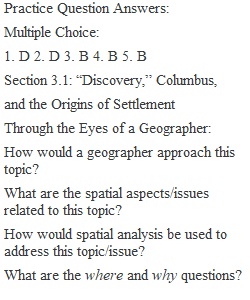


Q Section 3.1: “Discovery,” Columbus, and the Origins of Settlement Through the Eyes of a Geographer: How would a geographer approach this topic? What are the spatial aspects/issues related to this topic? How would spatial analysis be used to address this topic/issue? What are the where and why questions? How can this topic be studied and analyzed using the five themes of geography? Overview: You might ask why Columbus would be discussed in a section devoted to the historical geography of settlement in the United States, since he never landed on what would become U.S. shores. In order to fully understand how the United States was “discovered” and settled by Europeans, it is first necessary to examine the reality of Columbus and to learn how his actions paved the way for subsequent European settlement of the “New World.” It is also necessary to examine the values and beliefs commonly held by Columbus and other “New World” settlers that led to the domination and subjugation of the physical environment and the indigenous peoples. Finally, we most think critically about the terms ”explorers,” “discovery,” “New World,” and “Indians” and ask if there are more appropriate or accurate terms to describe early European motivations and intensions. Critical Thinking/Discussion Questions: 1. Discuss the role of selective information in the perception of Columbus. Do you think that he is a hero or a villain? Why? 2. What role did the physical environment play in the “discovery,” colonization and settlement of what is now the United States? Discuss human environment interaction during early settlement. 3. How did the beliefs and values of European settlers shape their actions in the “New World?” What was the overall view of the environment and the indigenous peoples? Are those beliefs and values still held by present-day Americans? Practice Questions (Write Correct Answer in Blank): Multiple Choice: 1. ___ This term implies “a divinely inspired occupancy” and human control over nature: A) Environmental Determinism B) Lifeboat Ethics C) Stewardship D) Manifest Destiny 2. ___ Columbus actually landed in this world region: A) Mexico B) India C) South Carolina D) Caribbean 3. ___ The dominant economic activity in the original thirteen colonies of the U.S.: A) industry B) agriculture C) large-scale manufacturing D) service sector 4. ___ What European group explored and settled along the Mississippi River: A) Spanish B) French C) Portuguese D) English 5. ___ The term indigenous implies: A) poor B) local or native C) exotic D) modern or wealthy True or False: 1. ___ North America has relatively few natural resources. 2. ___ The American colonists used guerilla-type warfare to help defeat the British. 3. ___ All Americans consider Columbus a hero and celebrate Columbus Day as a holiday. 4. ___ New York City was founded by the Dutch in the early 1600s as New Amsterdam. 5. ___ In migration studies, pull factors are those conditions that serve to attract people from one region to another.
View Related Questions